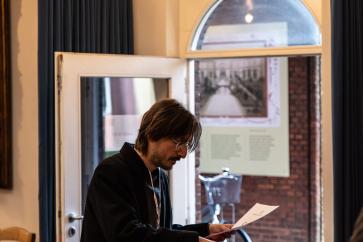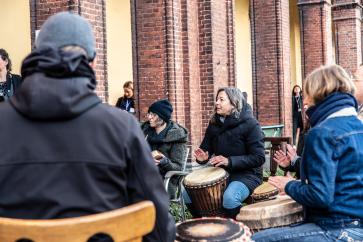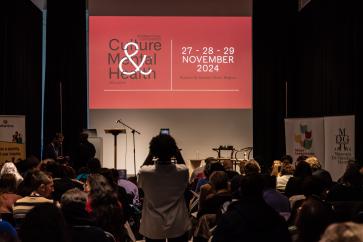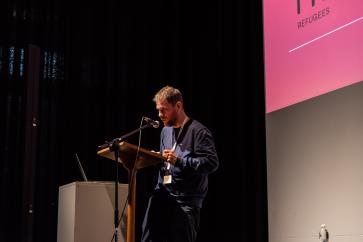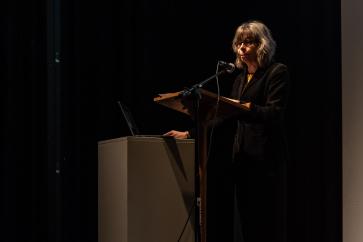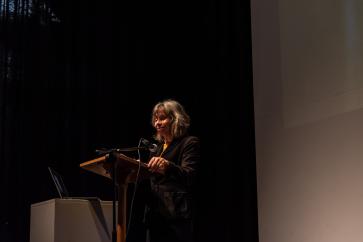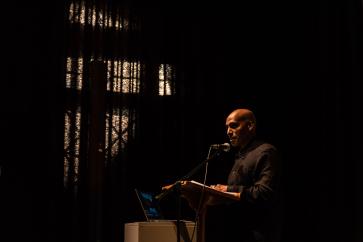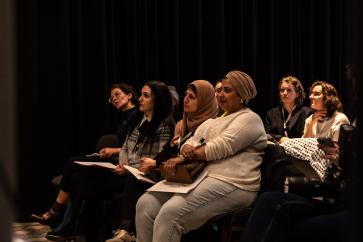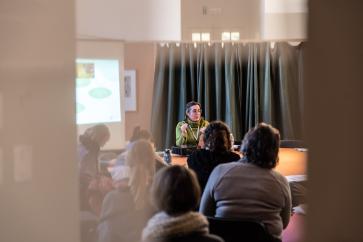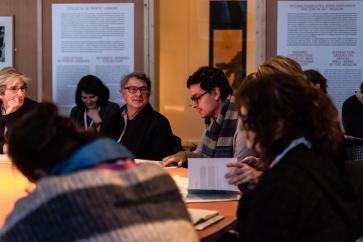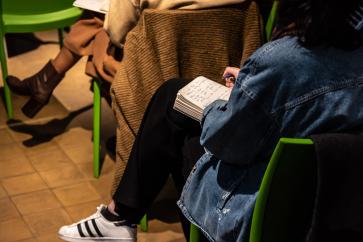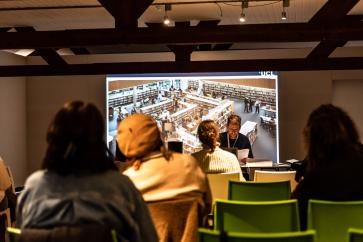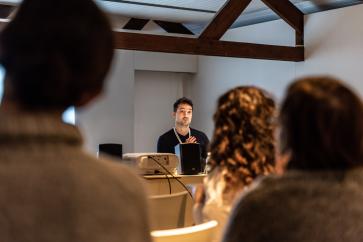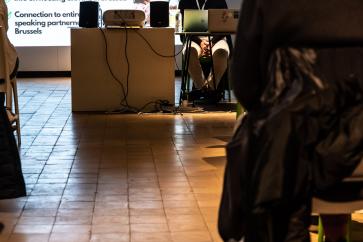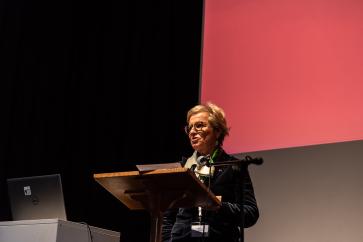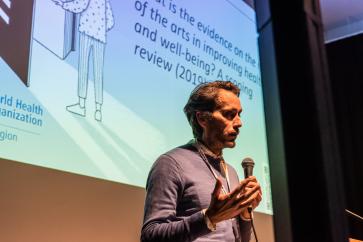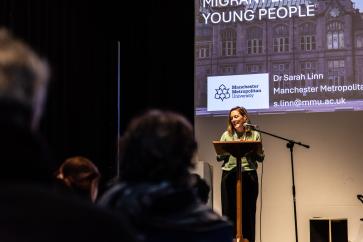Art as a lifeline: how culture supports refugees' mental health
The second International Conference on Culture & Mental Health, held in Ghent from 27 to 29 November 2024, brought together a dynamic mix of experts, artists, and advocates. Their mission? To highlight the transformative power of arts and culture in nurturing the mental well-being of refugees. A wide range of research and projects showcased how creative expression, books and stories offer solace, healing and a sense of belonging to those who have been forcibly displaced.
Text by Maya Toebat
-> Naar de Nederlandstalige versie van dit artikel
At the bottom of this page, you can find an image gallery to relive the conference and all the presentations.
Two years after the successful previous edition, the international conference on Culture & Mental Health returned in November 2024, this time focusing on refugees’ needs. Organized by Dr. Guislain Museum, Iedereen Leest, Solentra, and the Red Star Line Museum, the conference explored the power of arts and culture in supporting the mental health of forcibly displaced people. Curator Bart De Nil (UCL) assembled a program featuring over 50 speakers, representing international organizations, NGOs, cultural institutions, universities, and grassroots organizations. They delved into a wide range of topics, including using arts and crafts, books, stories, theatre, and music to improve the well-being and resilience of refugees. More than 250 professionals from 24 countries attended the conference.
‘How can we empower forcibly displaced people in their mental, physical, and social health?’, asked Sylvie Dhaene (director of Iedereen Leest) in her opening remarks. ‘How can we create “places of care” for refugees through our arts & crafts practices? How can librairies, museums, theaterhouses, art and other cultural spaces help refugees to build resilience, find hope, and thrive in their new environments?’ With an urgent call to action, she set the stage for inspiring presentations and discussions.
Stories fostering imagination
Renowned authors Marit Törnqvist and Sulaiman Addonia opened the conference with a keynote about their personal experiences and insights into the power of storytelling. Marit Törnqvist, a Swedish-Dutch writer and illustrator, realized the importance of arts after a visit to the refugee centre in her village in Sweden. In the workshop she gave, children were drawing houses that no longer existed, rebuilding them with their imagination. One day, she brought also her books to the centre, but the people didn’t understand the language. Only one book that she illustrated - The red bird by Astrid Lindgren – was translated into Arabic, so she decided to bring that book. ‘What happened next was incredible’, she recalled. ‘Young and old dived for the book, they read it out loud and wanted to own it, but I only had one copy. Suddenly everything became clear: refugees want access to our stories, but in their languages. The familiar words made them feel at home.’
She wrote letters to her publisher and the government, and thanks to her initiative, thousands of books have been handed as a welcome gift to children in asylum centres in Sweden and the Netherlands. ‘In an increasingly refugee-unfriendly world, we need counter-initiatives that remind refugees that there is a place for them’, she concluded. ‘I also saw this during a workshop in an Iranian refugee camp with Afghan children. One of the boys told me that books allow him to be everywhere. That reading is surviving. The difference between no books and books is the difference between despair and hope.’
“In an increasingly refugee-unfriendly world, we need counter-initiatives that remind refugees that there is a place for them. And books allow them to be everywhere. The difference between no books and books is the difference between despair and hope.”
This is exactly the feeling of Sulaiman Addonia, a British-Eritrean-Ethiopian author and refugee himself. Reading and writing helped him cope with the challenges of displacement and find solace in the world of imagination. Despite limited access to books, storytellers were always present in his life. ‘There was an old man in a refugee camp who evoked fantasy stories’, he remembered. ‘Or my mother, who cannot write or read, but recorded tapes and sent them to me and my brother. I remember the emotion in her voice, the details… Her descriptive style enabled me to imagine where she was. Many years later, I use the same descriptive technique in my books.’
(The text continues below the photo.)
When he and his brother left Eritrea for Sudan, where he moved from camp to camp, books became forbidden due to censorship, so they had to smuggle them. ‘We took the risk because literature made us grow as citizens. We felt connected to people like Agatha Christie, Virginia Woolf, Charles Dickens, whom we had never met.’ Arriving in London as an unaccompanied minor, he faced further challenges in accessing literature. With a budget of 17 pounds a week, he realized the fundamental right to read was not universal. ‘Art is reserved for the privileged. To enjoy art and buy books, I had to starve myself. But I needed it so much because it was the only world where I belonged. Surrounded by art, I didn’t need the family and friends I had lost. This was vital to relieve my mental pressure.’ Therefore, in the absence of books, he trained to read in other ways. ‘Everything around us, the people, trees… have a story. The street is the most diverse and accessible library, and people are books.’
READ MORE: Sulaiman Addonia's World of Reading
Libraries as places of connection
Displacement often means losing access to cultural practices and tools like books. On top of that, refugees struggle to connect with people in their new communities. The conference showcased various projects that support refugees’ mental health through art. One of these is the transformation of libraries into resources for refugees, offering language learning opportunities, access to information and social interaction.
Conference curator Bart De Nil (UCL) observed that libraries increasingly invest in health and well-being, offering refugees support. His interdisciplinary research in the UK and Belgium includes cultural heritage activities for refugees delivered by library teams. By focusing on the librarians, he tries to figure out the staffing implications when a library becomes a social infrastructure for the creative health of displaced people. Jamie Johnston, coordinator of Public Libraries for Immigrants and Refugees (PubLIB), also studied how public libraries address the needs of recently arrived refugees and immigrants. She found that language learning programs in libraries foster social integration, as shown in her research in three Swedish libraries. Participants not only learned new languages but also connected with others, thereby reducing prejudices.
Muntpunt, in Brussels, is an example of a public library that offers integrational activities for refugees. Director Roel van den Sigtenhorst explained how the library needs to be redefined in a world with unlimited public information. ‘A library is more than a collection of books. It also provides information, new skills and education, guidance and human connections. Our library aims to be crucial for refugees, serving as an information point, a gathering place and a community facilitator.’ Van den Sigtenhorst sees the public library as a ‘third space’, a platform to enhance the creative energy of citizens.
This belief is shared by Permeke, the central library in Antwerp. In cooperation with Red Star Line Museum and SAAMO Antwerp, it has created a ‘herbal and reading garden’: a gathering point for various groups and people. ‘Permeke is situated in the neighbourhood where people arrive in the city. After a few years, they move on’, explained Lieve Willekens. ‘The library is open to all, but this sometimes leads to issues like drugs, alcohol, and aggression. To make this public space safer, especially for women, we started with the garden: a place of women, of herbs and well-being, and of stories.’ Every Thursday, women from diverse backgrounds meet there, bonding over plants that remind them of their homeland. The library feels like a second home, and the women become engaged in the library, translating books and reading. One of the ladies, Zoukha, shared at the conference: ‘I love that this project is not top-down. We, the women, make the decisions. Every woman chose a plant connected to her personal story, and together we make tea with the herbs.’
(The text continues below the photo.)
Shared Reading in the museum
Libraries, museums, and other cultural institutions play a crucial role in fostering connection and recognition for refugees. The Red Star Line Museum in Antwerp, which tells the story of the emigrants who travelled from Europe to America by boat a century ago, aims to be such an open space for refugees. One of the initiatives is ‘shared reading’ for second-language learners. Speaker Ilona Plichart is one the hosts. During the sessions, she reads a (simplified) letter from the museum collection out loud, the participants listen and can follow along with the printed text, and afterwards a conversation about the story follows.
The stories of people leaving Europe for the United States resemble current refugee experiences, Plichart noticed. ‘I remember a group of Iranian women who began to share their own experiences of longing for their husbands. The emotions are the same as a century ago. You carry these emotions as a group and connect through stories. That is the beauty of reading together.’ While language learning is a benefit, the primary goal is to create a safe space for social interaction and cultural exchange. Plichart: ‘The museum is an open space for socializing, meeting, connecting and experiencing art and beauty. By participating in “shared reading”, refugees and migrants grow not only linguistically but on all levels.’
Evidence-based
The Culture & Mental Health conference highlighted so many projects that support the well-being of refugees through arts. This approach is also grounded in evidence-based research. A 2022 report by the EU and WHO emphasized the importance of arts and culture in promoting the mental health of forcibly displaced people. The report underlined that a large body of evidence shows how forcibly displaced people contribute positively to society. This potential can be further enhanced by ensuring good physical and mental health. Engagement in arts activities positively impacts forcibly displaced people, as well as their host community, by promoting social inclusion, social cohesion, social acceptance and belonging.
“Investing in the arts field is an investment in the mental, physical, and social health of forcibly displaced people.”
Nils Fietje, who coordinated this first-ever WHO report on the evidence base for arts and health interventions, echoed the sentiment. In his key note, he called for increased support for arts and culture initiatives that benefit refugees. ‘Investing in the arts field is an investment in the mental, physical, and social health of forcibly displaced people,’ he concluded. ‘By supporting these programs, we can help create a more compassionate and inclusive world for all.’
In his wrap up, Bart Marius, artistic director of Dr. Guislain Museum, emphasizes the importance of stories and narratives as livesavers. They are a way to reconnect personal histories to the outside world. 'Here, in this museum on psychiatry and mental health care, this conference landed, and made clear how important it is to listen, to slow down, to look and especially to take care in every possible way.'
Relive the conference
All pictures: © Simon Bequoye & Iedereen Leest
Below the image gallery, you'll find the presentations of this conference
Presentations
KEYNOTES
- Nils Fietje - WHO Europe
- Sarah Linn - Manchester Metropolitan University
- Manon Parry - University of Amsterdam
SESSION 1 - Place & language
SESSION 2 - Lived experience of displacement
- Recreation as therapy - Ute Oswald
- Co-collaboration with refugees - Vincen Beeckman & Aimee Kelley
- Putting people at the heart of care - Loes Kuijpers
- Putting people at the heart of care - Xavier Verhoest
- Light after loss - Katya Provornaya
SESSION 3 - Communities & resilience
SESSION 4 - Children & young adults
- Voice Notes - Sarah Jackson & Leah Gayer
- Art activities as psyschological intervention - Tengku Nila Fadhlia
SESSION 5 - Communities & resilience
- Psychosocial support using drama and playback theatre - Fayez Alabbas
- MIITTI: Bridging Gaps and Creating Bonds - Alaa Altamimi
- From Here to Home - Alison Luyten
- Body-maps as empowerment tool for refugees living with HIV - Christiana Noestlinger











